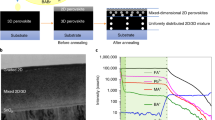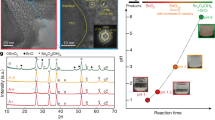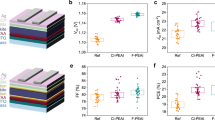Abstract
Reducing non-radiative recombination in semiconducting materials is a prerequisite for achieving the highest performance in light-emitting and photovoltaic applications. Here, we characterize both external and internal photoluminescence quantum efficiency and quasi-Fermi-level splitting of surface-treated hybrid perovskite (CH3NH3PbI3) thin films. With respect to the material bandgap, these passivated films exhibit the highest quasi-Fermi-level splitting measured to date, reaching 97.1 ± 0.7% of the radiative limit, approaching that of the highest performing GaAs solar cells. We confirm these values with independent measurements of internal photoluminescence quantum efficiency of 91.9 ± 2.7% under 1 Sun illumination intensity, setting a new benchmark for these materials. These results suggest hybrid perovskite solar cells are inherently capable of further increases in power conversion efficiency if surface passivation can be combined with optimized charge carrier selective interfaces.
This is a preview of subscription content, access via your institution
Access options
Access Nature and 54 other Nature Portfolio journals
Get Nature+, our best-value online-access subscription
$29.99 / 30 days
cancel any time
Subscribe to this journal
Receive 12 print issues and online access
$209.00 per year
only $17.42 per issue
Buy this article
- Purchase on Springer Link
- Instant access to full article PDF
Prices may be subject to local taxes which are calculated during checkout




Similar content being viewed by others
References
Sutherland, B. R. & Sargent, E. H. Perovskite photonic sources. Nat. Photon. 10, 295–302 (2016).
Zhang, W., Eperon, G. E. & Snaith, H. J. Metal halide perovskites for energy applications. Nat. Energy 1, 16048 (2016).
De Wolf, S. et al. Organometallic halide perovskites: sharp optical absorption edge and its relation to photovoltaic performance. J. Phys. Chem. Lett. 5, 1035–1039 (2014).
Stranks, S. D. et al. Electron–hole diffusion lengths exceeding 1 micrometer in an organometal trihalide perovskite absorber. Science 342, 341–344 (2013).
deQuilettes, D. W. Photoluminescence lifetimes exceeding 8 μs and quantum yields exceeding 30% in hybrid perovskite thin films by ligand passivation. ACS Energy Lett. 1, 438–444 (2016).
Herz, L. M. Charge-carrier mobilities in metal halide perovskites: fundamental mechanisms and limits. ACS Energy Lett. 2, 1539–1548 (2017).
Richter, J. M. et al. Enhancing photoluminescence yields in lead halide perovskites by photon recycling and light out-coupling. Nat. Commun. 7, 13941 (2016).
Tress, W. Perovskite solar cells on the way to their radiative efficiency limit—insights into a success story of high open-circuit voltage and low recombination. Adv. Energy Mater. 7, 1602358 (2017).
Deschler, F. et al. High photoluminescence efficiency and optically pumped lasing in solution-processed mixed halide perovskite semiconductors. J. Phys. Chem. Lett. 5, 1421–1426 (2014).
Tvingstedt, K. et al. Radiative efficiency of lead iodide based perovskite solar cells. Sci. Rep. 4, 6071 (2014).
Shockley, W. & Queisser, H. J. Detailed balance limit of efficiency of p–n junction solar cells. J. Appl. Phys. 32, 510–519 (1961).
Rau, U. Reciprocity relation between photovoltaic quantum efficiency and electroluminescent emission of solar cells. Phys. Rev. B 76, 085303 (2007).
Katahara, J. K. & Hillhouse, H. W. Quasi-Fermi level splitting and sub-bandgap absorptivity from semiconductor photoluminescence. J. Appl. Phys. 116, 173504 (2014).
Amani, M. et al. Near-unity photoluminescence quantum yield in MoS2. Science 350, 1065–1068 (2015).
Tiedje, T., Yablonovitch, E., Cody, G. D. & Brooks, B. G. Limiting efficiency of silicon solar cells. IEEE Trans. Electron. Devices 31, 711–716 (1984).
Green, M. A. et al. Solar cell efficiency tables (version 49). Prog. Photovolt. Res. Appl. 25, 3–13 (2017).
Trupke, T. et al. Very efficient light emission from bulk crystalline silicon. Appl. Phys. Lett. 82, 2996–2998 (2003).
Yao, J. et al. Quantifying losses in open-circuit voltage in solution-processable solar cells. Phys. Rev. Appl. 4, 014020 (2015).
Miller, O. D., Yablonovitch, E. & Kurtz, S. R. Strong internal and external luminescence as solar cells approach the Shockley–Queisser limit. IEEE J. Photovolt. 2, 303–311 (2012).
Schnitzer, I., Yablonovitch, E., Caneau, C. & Gmitter, T. J. Ultra-high spontaneous emission quantum efficiency, 99.7% internally and 72% externally, from AlGaAs/GaAs/AlGaAs double heterostructures. Appl. Phys. Lett. 62, 131–133 (1993).
Correa-Baena, J. P. et al. Promises and challenges of perovskite solar cells. Science 358, 739–744 (2017).
Pazos-Outon, L. M. et al. Photon recycling in lead iodide perovskite solar cells. Science 351, 1430–1433 (2016).
Yang, Y. et al. Top and bottom surfaces limit carrier lifetime in lead iodide perovskite films. Nat. Energy 2, 16207 (2017).
Noel, N. K. et al. Enhanced photoluminescence and solar cell performance via Lewis base passivation of organic–inorganic lead halide perovskites. ACS Nano 8, 9815–9821 (2014).
Stewart, R. J. et al. Approaching bulk carrier dynamics in organo-halide perovskite nanocrystalline films by surface passivation. J. Phys. Chem. Lett. 7, 1148–1153 (2016).
Aberle, A. G. Surface passivation of crystalline silicon solar cells: a review. Prog. Photovolt. Res. Appl. 8, 473–487 (2000).
Bertness, K. A. et al. 29.5%-efficient GaInP/GaAs tandem solar cells. Appl. Phys. Lett. 65, 989–991 (1994).
Zheng, X. et al. Defect passivation in hybrid perovskite solar cells using quaternary ammonium halide anions and cations. Nat. Energy 2, 17102 (2017).
Pazos-Outon, L. M., Xiao, T. P. & Yablonovitch, E. Fundamental efficiency limit of lead iodide perovskite solar cells. J. Phys. Chem. Lett. 9, 1703–1711 (2018).
Kirchartz, T., Staub, F. & Rau, U. Impact of photon recycling on the open-circuit voltage of metal halide perovskite solar cells. ACS Energy Lett. 1, 731–739 (2016).
Yablonovitch, E., Miller, O. D. & Kurtz, S. R. The opto-electronic physics that broke the efficiency limit in solar cells. 38 th IEEE Photovoltaic Specialists Conference 001556–001559 (IEEE, 2012).
Zhang, W. et al. Ultrasmooth organic–inorganic perovskite thin-film formation and crystallization for efficient planar heterojunction solar cells. Nat. Commun. 6, 6142 (2015).
Saliba, M. et al. Incorporation of rubidium cations into perovskite solar cells improves photovoltaic performance. Science 354, 206–209 (2016).
Bauer, G. H., Brüggemann, R., Tardon, S., Vignoli, S. & Kniese, R. Quasi-Fermi level splitting and identification of recombination losses from room temperature luminescence in Cu(In1–xGa x )Se2 thin films versus optical band gap. Thin Solid Films 480, 410–414 (2005).
Ross, R. T. Some thermodynamics of photochemical systems. J. Chem. Phys. 46, 4590–4593 (1967).
deQuilettes, D. W. et al. Impact of microstructure on local carrier lifetime in perovskite solar cells. Science 348, 683–686 (2015).
Kayes, B. M. et al. 27.6% conversion efficiency, a new record for single-junction solar cells under 1 sun illumination. 37th IEEE Photovoltaic Specialists Conference 000004–000008 (IEEE, 2011).
Drexhage, K. H. Fluorescence efficiency of laser dyes. J. Res. Natl Bur. Stand. A 80A, 421 (1976).
Johnston, M. B. & Herz, L. M. Hybrid perovskites for photovoltaics: charge-carrier recombination, diffusion, and radiative efficiencies. Acc. Chem. Res. 49, 146–154 (2016).
Stranks, S. D. et al. Recombination kinetics in organic-inorganic perovskites: excitons, free charge, and subgap states. Phys. Rev. Appl. 2, 034007 (2014).
Lin, Q. et al. Hybrid perovskites: prospects for concentrator solar cells. Adv. Sci. 2018, 1700792 (2018).
Stranks, S. D. Nonradiative losses in metal halide perovskites. ACS Energy Lett. 2, 1515–1525 (2017).
Stoumpos, C. C., Malliakas, C. D. & Kanatzidis, M. G. Semiconducting tin and lead iodide perovskites with organic cations: phase transitions, high mobilities, and near-infrared photoluminescent properties. Inorg. Chem. 52, 9019–9038 (2013).
Sandroff, C. J., Nottenburg, R. N., Bischoff, J. C. & Bhat, R. Dramatic enhancement in the gain of a GaAs/AlGaAs heterostructure bipolar transistor by surface chemical passivation. Appl. Phys. Lett. 51, 33–35 (1987).
Yablonovitch, E., Sandroff, C. J., Bhat, R. & Gmitter, T. Nearly ideal electronic properties of sulfide coated GaAs surfaces. Appl. Phys. Lett. 51, 439–441 (1987).
Knesting, K. M. et al. ITO interface modifiers can improve V OC in polymer solar cells and suppress surface recombination. J. Phys. Chem. Lett. 4, 4038–4044 (2013).
Stoddard, R. J., Eickemeyer, F. T., Katahara, J. K. & Hillhouse, H. W. Correlation between photoluminescence and carrier transport and a simple in-situ passivation method for high-bandgap hybrid perovskites. J. Phys. Chem. Lett. 8, 3289–3298 (2017).
deQuilettes, D. W. et al. Tracking photoexcited carriers in hybrid perovskite semiconductors: trap-dominated spatial heterogeneity and diffusion. ACS Nano 11, 11488–11496 (2017).
Wang, T. et al. Indirect to direct bandgap transition in methylammonium lead halide perovskite. Energy Environ. Sci. 10, 509–515 (2017).
Kirchartz, T. & Rau, U. Decreasing radiative recombination coefficients via an indirect band gap in lead halide perovskites. J. Phys. Chem. Lett. 8, 1265–1271 (2017).
Wright, A. D. et al. Band-tail recombination in hybrid lead iodide perovskite. Adv. Funct. Mater. 27, 1700860 (2017).
Ziffer, M. E., Mohammed, J. C. & Ginger, D. S. Electroabsorption spectroscopy measurements of the exciton binding energy, electron–hole reduced effective mass, and band gap in the perovskite CH3NH3PbI3. ACS Photon. 3, 1060–1068 (2016).
de Mello, J. C., Wittmann, H. F. & Friend, R. H. An improved experimental determination of external photoluminescence quantum efficiency. Adv. Mater. 9, 230–232 (1997).
Edelstein, A. D. et al. Advanced methods of microscope control using μManager software. J. Biol. Methods 1, e10 (2014).
Blattner, T. et al. A hybrid CPU–GPU system for stitching large scale optical microscopy images. 43rd International Conference on Parallel Processing (IEEE, 2014).
Schindelin, J. et al. Fiji: an open-source platform for biological-image analysis. Nat. Methods 9, 676–682 (2012).
Acknowledgements
D.W.D. and D.S.G. acknowledge the US Department of Energy (DOE) (DE-SC0013957) for supporting the microscopy work. D.W.D. acknowledges support from an NSF Graduate Research Fellowship (DGE-1256082) and thanks L. Flagg for experimental help. I.L.B. and H.W.H. acknowledge financial support from the US DOE SunShot Initiative, Next Generation Photovoltaics 3 program, Award DE-EE0006710. Part of this work was conducted at the Molecular Analysis Facility and at the Washington Nanofabrication Facility, two National Nanotechnology Coordinated Infrastructure sites at the University of Washington, which are supported in part by the NSF (grant no. ECC-1542101), the University of Washington, the Molecular Engineering and Sciences Institute, the Clean Energy Institute and the National Institutes of Health. L.M.P.-O was supported by the Kavli Energy NanoScience Institute Heising-Simons Junior Fellowship of the University of California, Berkeley. The authors acknowledge F. Deschler for his helpful discussions.
Author information
Authors and Affiliations
Contributions
The project was conceived, planned and coordinated by D.W.D., I.L.B., H.W.H. and D.S.G. Samples were prepared by I.L.B., D.W.D. and S.B. Absolute-intensity photoluminescence spectra and fits were completed by I.L.B. Integrating sphere measurements were conducted by D.W.D. Intensity and temperature-dependent measurements were collected by I.L.B. and D.W.D. L.M.P.-O assisted in extracting the internal PLQE and calculating photovoltaic device metrics. M.E.Z. performed ellipsometry measurements and analysis. All authors assisted in the interpretation of results. D.W.D. and I.L.B wrote the manuscript, and all authors helped with editing.
Corresponding authors
Ethics declarations
Competing interests
The authors declare no competing interests.
Additional information
Publisherʼs note: Springer Nature remains neutral with regard to jurisdictional claims in published maps and institutional affiliations.
Supplementary information
Supplementary Information
Additional analysis and modelling.
Rights and permissions
About this article
Cite this article
Braly, I.L., deQuilettes, D.W., Pazos-Outón, L.M. et al. Hybrid perovskite films approaching the radiative limit with over 90% photoluminescence quantum efficiency. Nature Photon 12, 355–361 (2018). https://doi.org/10.1038/s41566-018-0154-z
Received:
Accepted:
Published:
Issue Date:
DOI: https://doi.org/10.1038/s41566-018-0154-z
This article is cited by
-
Reduced recombination via tunable surface fields in perovskite thin films
Nature Energy (2024)
-
Electrically assisted amplified spontaneous emission in perovskite light-emitting diodes
Nature Photonics (2024)
-
Shallow defects and variable photoluminescence decay times up to 280 µs in triple-cation perovskites
Nature Materials (2024)
-
A systematic discrepancy between the short circuit current and the integrated quantum efficiency in perovskite solar cells
Nature Communications (2023)
-
Interface Passivation of Perovskite Solar Cells by Fmoc-Ala-OH Amino Acids
Journal of Electronic Materials (2023)



